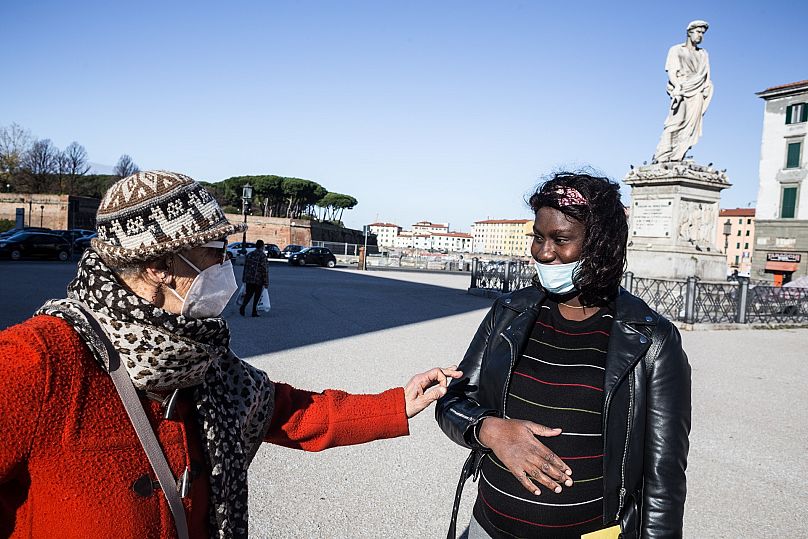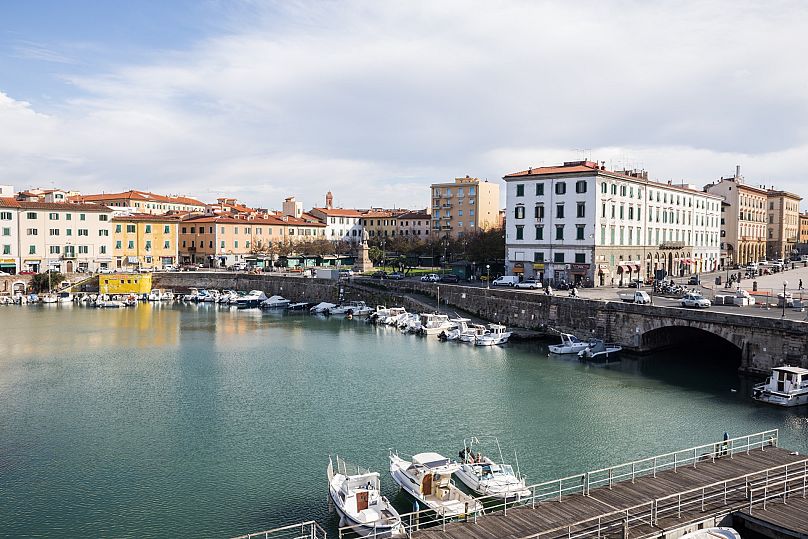In the Tuscan coastal city of Livorno, a social project matches young migrants with elderly residents in need of help or companionship.
Under the midday sun, Maty and Alma are walking across Livorno's Garibaldi Square. Nearly 60 years separate them but the young immigrant and the elderly Italian woman are getting to know each other as part of a social project that sees mutual aid and solidarity provide new hope in the port city.
The "Riconoscerci Solidali" initiative was launched last year by the "Mezclar22" association in collaboration with CESDI - The Immigrant Women's Service Center — with the funding from the Waldensian Church. Its aim is to develop labour inclusion and solidarity practices with young immigrants and refugees helping some of the neighbourhood's older residents. They do their grocery shopping, deliver medicine or just provide company.
Volunteers, meanwhile, earn a small income, improve their Italian and learn about the city they now call home. But the project's main results are the increased autonomy of those involved and the new relationships that flourish between people who might never have met in other circumstances due to their different ages, ethnicities and backgrounds.
It's part of the association's wider "La Riuso" social project which has, since 2017, been offering activities for children, sewing workshops and Italian language courses in and around Garibaldi Square.
A new social fabric
Garibaldi is an underclass neighbourhood close to the centre of the Tuscan coastal city. It is often depicted as a rough district, but in these streets, working-class roots and new migrations stories are bumping into each other and weaving a new social fabric.
Many families have left the district over the last few decades to settle in suburban flats and so Garibaldi is now mainly populated by elderly people. But new inhabitants are coming including young local people, low-income families and immigrants.
Maty, 26, is from Senegal but settled in Livorno five years ago.
"I had started my studies in Senegal. I would have liked to continue with university, but then I had my first child, and I could not continue," she told Euronews.
She still has difficulties with Italian, and dealing with older people is not always easy, but she decided to take part in the project to improve her language skills and earn some money.
Alma, 82, has travelled a lot but has always lived in Livorno. She loves her home town and cultivates its memory. Her flat is a short step from La Riuso and, as she says, she joined the project not because of a real need but in order to get to know the neighbourhood's new inhabitants.
"Livorno has always been welcoming to everyone, it didn't even have a ghetto, but now there are idiot racists here too!," she said, gently touching Maty's elbow.
They go on walking, slowly crossing the square, right behind Garibaldi’s statue that, standing on its pedestal, looks towards the industrial port.
A diverse history
The town lies in a harbour oriented towards the islands of Corsica and Sardinia. It was founded in the early XVII century by the Medici family, Grand Dukes of Tuscany, in need of a modern port and has remained a free-trade outpost since then.
Different peoples from various Mediterranean and European countries built the town, attracted by religious and trading freedom. That’s the way many flourishing communities were born in Livorno. Today, a few traces of this history can still be found: in the remaining Jewish community, in religious buildings, old warehouses, cemeteries, villas and palaces.
For Alma, initiatives like "La Ruiso" are part of a wide pattern, bind tightly with the history of the town.
Lannseny is among the most active volunteers. He left his family in Northern Mali when he was 18 because of the war between Islamist militias and the central government of Bamako. Today he is 22 and he has been living in Livorno for three years now, following a stay on Lampedusa. Before reaching the Italian island by boat he was in Libya where was tortured by the police.
"I’m lucky, I remained there only one year," he said with a bitter smile.
Twice a week Lannseny goes shopping in the city market for Piero. The shopping list written by the elderly man is always very precise about the delicacies to buy. Health problems mean the 74-year-old really needs help.
Piero tells Lannseny his family’s stories. He speaks of hardships — his father was in a Nazi concentration camp during WWII — but also recounts funny anecdotes about the wine shop his great-uncle in a narrow street nearby.
For his part, the young Malian talks about his dreams and plans for the future: he would like to study, find a job as a mechanic and stay in Livorno.
An 'indispensable role'
But like everything else in 2020, the project was disrupted by the COVID-19 global health crisis.
"We had to stop the training in March. So volunteers concluded Italian lessons and psychology workshops only in July," Filippo, one of the Mezclar22's activities tutors, told Euronews.
The project started again in September — right before the second wave of the pandemic in Italy.
Veruska, Mezclar22's chair, added that while the association's activity is reduced because of the difficult period, "it is properly this context that shows its indispensable role."
Lansseny faced two consecutive quarantine periods of 14 days each, because of three infection cases in the Asylum Seekers Centre where he lives. From his perspective, the project is even more important now: "I can maintain relationships while being helpful in these hard times. I can also stay away from irregular and s****y jobs."
Social isolation is a real danger for the elderly population. Health risks and restrictions imposed by the government have made social interactions that much harder.
"I can break isolation thanks to this project," Alma said, "and I think this is even more important for ill or needy people".













